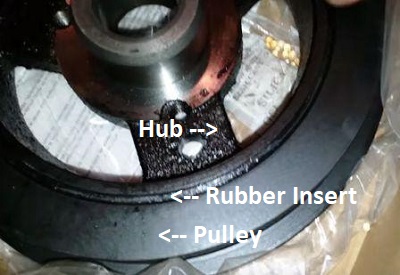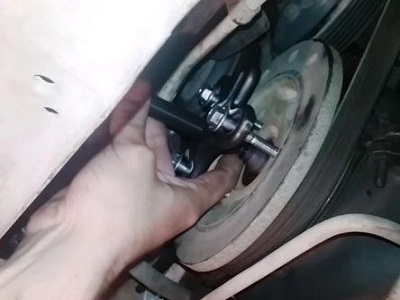Jeep Harmonic Balancer Problem
The Jeep harmonic balancer problem causes noise and vibration from the engine as RPM increases. This remains a big problem on Jeep Cherokee and Jeep Grand Cherokee, but also applies to many Jeep vehicles with a 4 L motor.
When you look at the crankshaft pulley you're actually looking at two separate pieces. They separate the two halves with a dense rubber insert.
We call the outer part the crankshaft pulley and the inner part the hub. However, when they press these two parts together at the factory it now becomes a harmonic balancer.
Quick Links:
New Jeep Grand Cherokee
Harmonic Balancer. Fits 1993-2020 Cherokee, Comanche, Wagoneer and Wrangler Models.
In this article about the Jeep harmonic balancer problem we'll cover diagnosis and repair procedures that help isolate the failed component.
With that said, what I wanted to go over first is why this repair might not be a great DIY car repair.
By the time the 2 halves start to separate and cause problems, these vehicles usually have well over 100,000 miles showing on the odometer.
Often when you remove the failed pulley assembly you find the front crankshaft seal leaking.
This is where the job can start snowballing. If you have the correct tools for the job, as in a seal puller and installer, I wouldn't hesitate for a moment to proceed with the crankshaft seal and crank pulley repairs.
However, when some try to substitute screwdrivers and pry bars, they wind up having to take off the timing cover.
Long story short, a Jeep harmonic balancer replacement can snowball into a larger job that the driveway warrior wasn't expecting.
 New Jeep Harmonic Balancer
New Jeep Harmonic BalancerWe'll get into this a little further below, but another thing worth mentioning. The Jeep harmonic balancer is pressed onto the crankshaft from the factory.
You will need a special tool to remove it. And when you go to remove it the crankshaft turns. You'll need a flywheel holder or equivalent tool to stabilize the crankshaft.
Unfortunately, you don't hear people talk about installing the new pulley assembly on some popular videos.
They make a separate tool for installing it correctly. In some cases experienced people can get creative with the installation of the new part and do so without an installer.
You do this at your own peril because if you mess up the threads in the crankshaft you're in trouble. Now let's get into the diagnosis and repair procedures and then move on to the repair tips.
Diagnosing Jeep Balancer Problems
It's ironic that the balancer designed to absorb engine vibration is now creating it. And that's the first sign that something isn't right. You can feel the engine moving around in a way it never did before while driving down the road.
Serpentine belt noise also becomes a major complaint when you have a Jeep harmonic balancer problem. Don't confuse this belt noise with the 4 L Jeep serpentine belt tensioner problem.
Why? Because the crankshaft pulley starts wondering up and back on the hub. This puts stress on the other belt driven accessories like the alternator and power steering pump.
If you let it go long enough, you could wind up replacing these parts due to bearing failure. So how do you diagnose a Jeep balancer problem?
There are many different ways to diagnose this issue, but I stick with these two methods outlined here. I like to remove the serpentine drive belt completely.
I recommend taking a cell phone picture of the belt installed so you can reference back to it later for the installation. With the belt removed you can physically grab the crankshaft pulley and see if you can move it at all.
Even the slightest movement between the pulley and the hub indicates a failed harmonic balancer. I use this second method for a quick check. From the ground I look at the crankshaft rotating from a safe distance while a friend lightly works the throttle.
Keep a close eye on the distance between the timing cover and the back of the crankshaft pulley. When a Mopar harmonic balancer fails, you'll see the distance increase and decrease as your assistant lightly works the throttle from idle to about 1,500 RPMs.
Tools for Replacing the Jeep Harmonic Balancer
 Removing Jeep Harmonic Balancer
Removing Jeep Harmonic BalancerI already own the tools needed to handle the Jeep harmonic balancer problem. These tools include a universal puller set, a pulley installer tool and a flywheel holding tool. In my opinion, you should either purchase or borrow this specialized equipment.
The good news is the grand total for all of the above listed items should come in below $100. This is a small consolation to somebody who will only use those tools one time. With that said, do-it-yourself auto mechanics are a creative bunch and have found interesting ways to eliminate some of the special tools I use to perform the repairs.
You can see a few of these interesting methods on YouTube videos outlining the replacement of the Jeep harmonic balancer. Here's why I recommend biting the bullet and at least getting two of the three tools I use to perform this repair.
You can come up with 10 different creative ways to hold the crankshaft from rotating while you knock the crankshaft pulley bolt loose.
Of course, if you have an air powered impact gun, then there’s no reason to worry about the crankshaft moving. Nevertheless, what concerns me the most is protecting the threaded hole in the center.
Using an installer tool helps press the new part on without having to worry about finding the right fine threaded bolt, nut and washer to do the job without the tool.
I want to mention one thing about the removal tool that most people will buy in the $35 range. A universal puller often removes the steering wheel as well as different types of pressed on pulleys.
The cheaper sets come with non-hardened cheaper bolts. When you read the reviews of people who purchase these tools they talk about having to replace the bolts that come with the set.
This might be a pain in the neck, but once you buy these replacement bolts the entire set can last a lifetime.
Putting Your Jeep Back Together
A lot of people ask how you know when the harmonic balancer is fully seated on the crankshaft during the installation procedure. The short answer is it stops when it gets to the right place, but you don't want to force it.
You can verify that it is in the correct position because there’s a shadow mark and sometimes a small ridge on the crankshaft where the part belongs. The next step is installing the bolt and washer, but you got to do this right also.
When you install the washer the clean side rides against the crankshaft hub. This specialized washer has a slight dome shape built in. You need to put the crankshaft bolt and washer on correctly or you can have premature failure of the new pulley assembly.
Here's another step I refuse to skip no matter how much of a hurry I'm in. The center crankshaft bolt has a specific torque specification. And its way up there at 118 foot-pounds.
This means that you will probably need a half inch drive torque wrench to ensure the proper tightness of the bolt.
Also note that the factory does not require a thread locking or an anti-seize compound applied to the threads. With a torque specification of 118 foot-pounds the bolt won't go anywhere when tightened properly.
We loaded this Jeep harmonic balancer problem article in the miscellaneous car repair area of the fix my old ride.com website. This is a great spot to see some unusual repairs that affect millions of vehicles.
Author bio : Mark is a retired ASE certified master technician, Chevrolet Professional Service Council member and the founder of FixMyOldRide.com. Watch the video on the about Mark the mechanic page to see his credentials. Mark hand writes all of the articles on FixMyOldRide.com unless indicated otherwise.